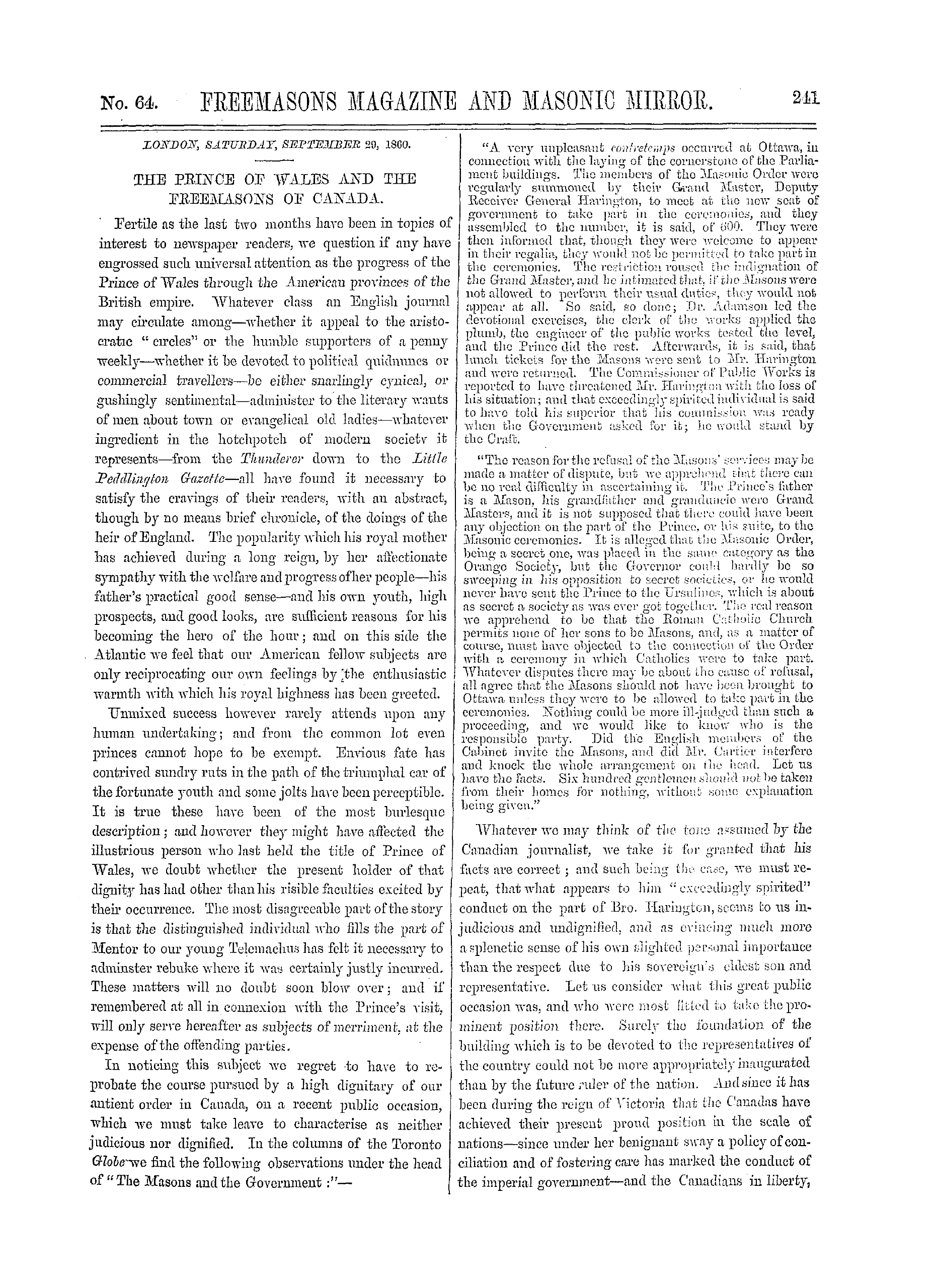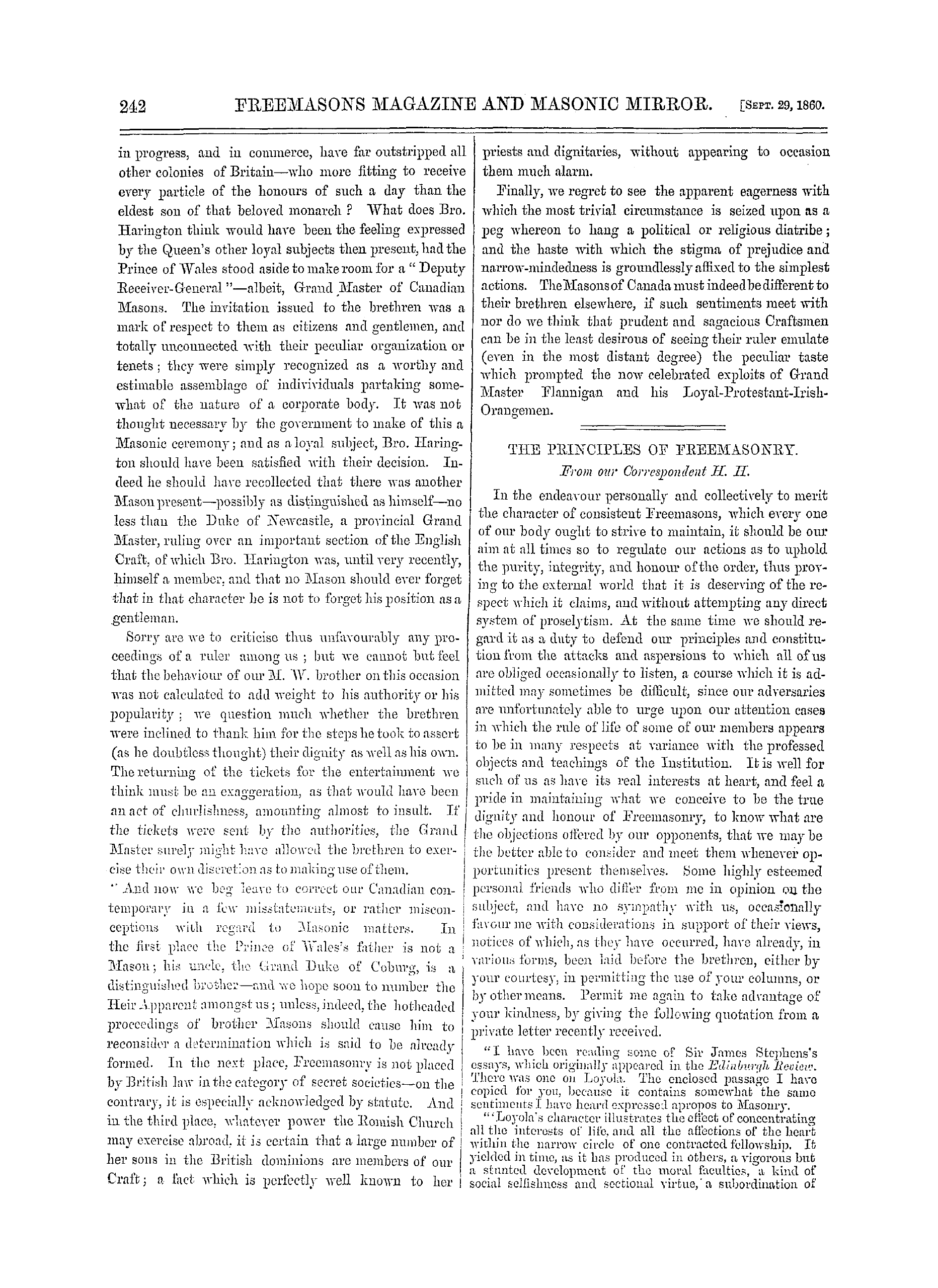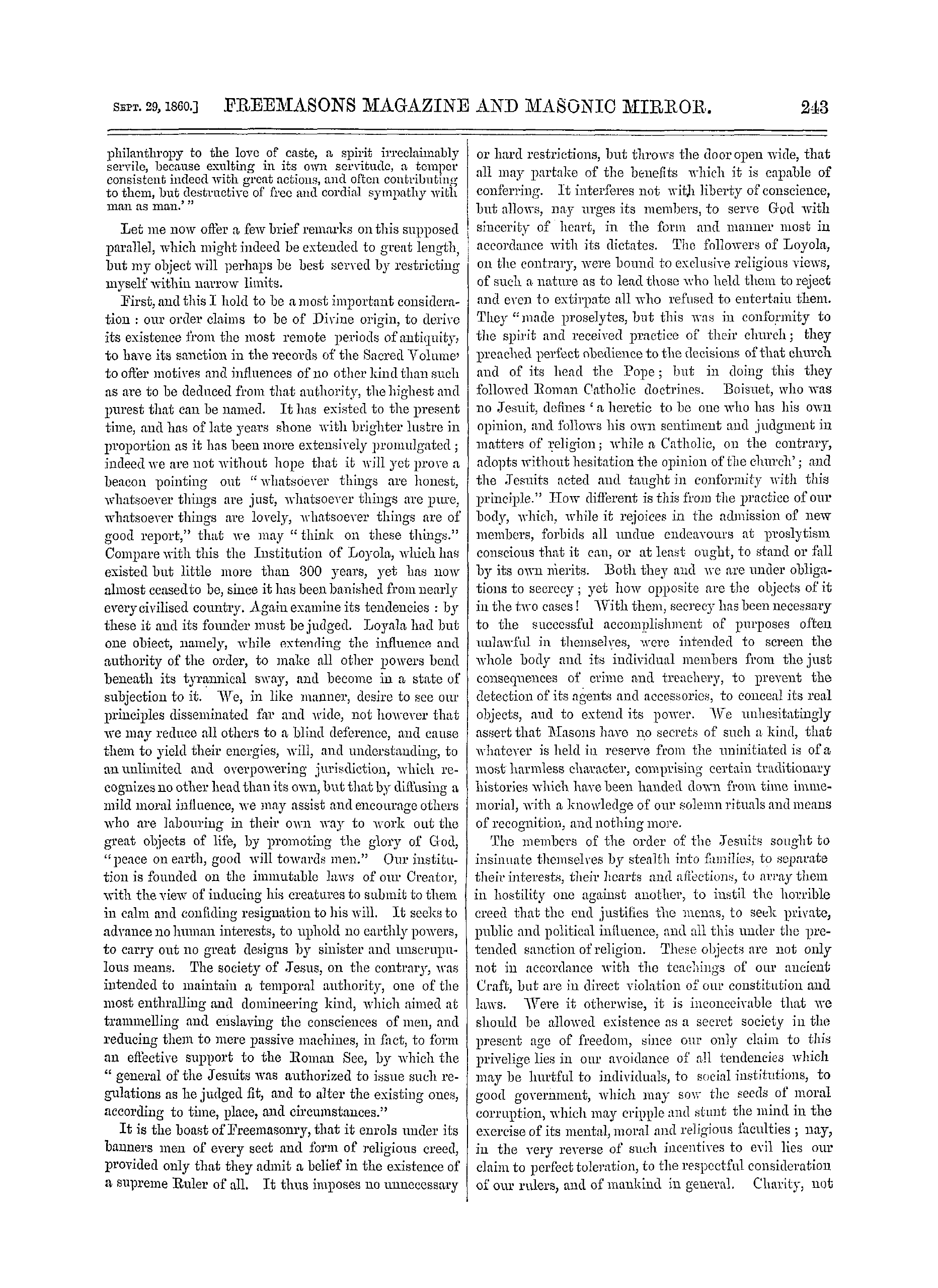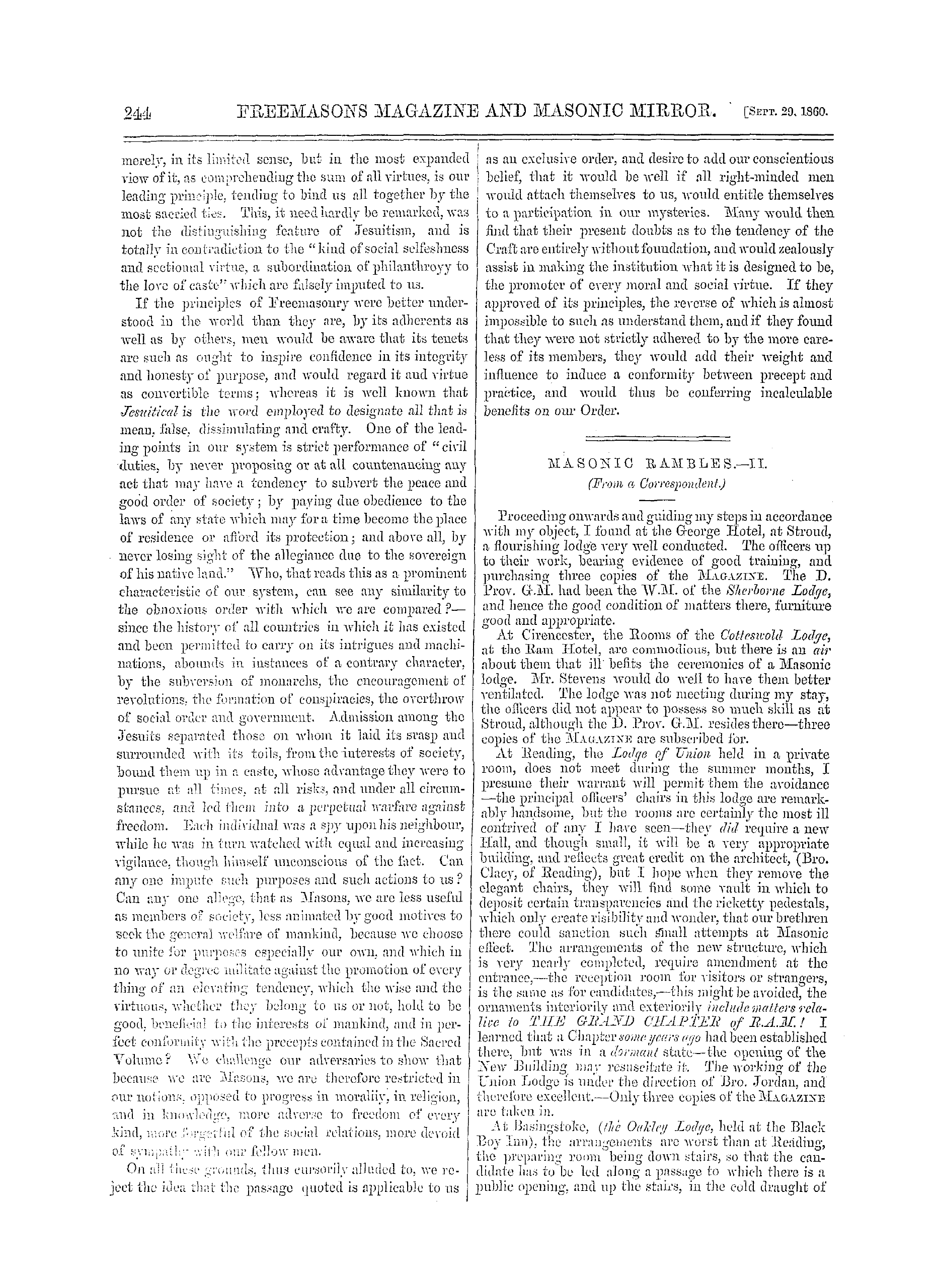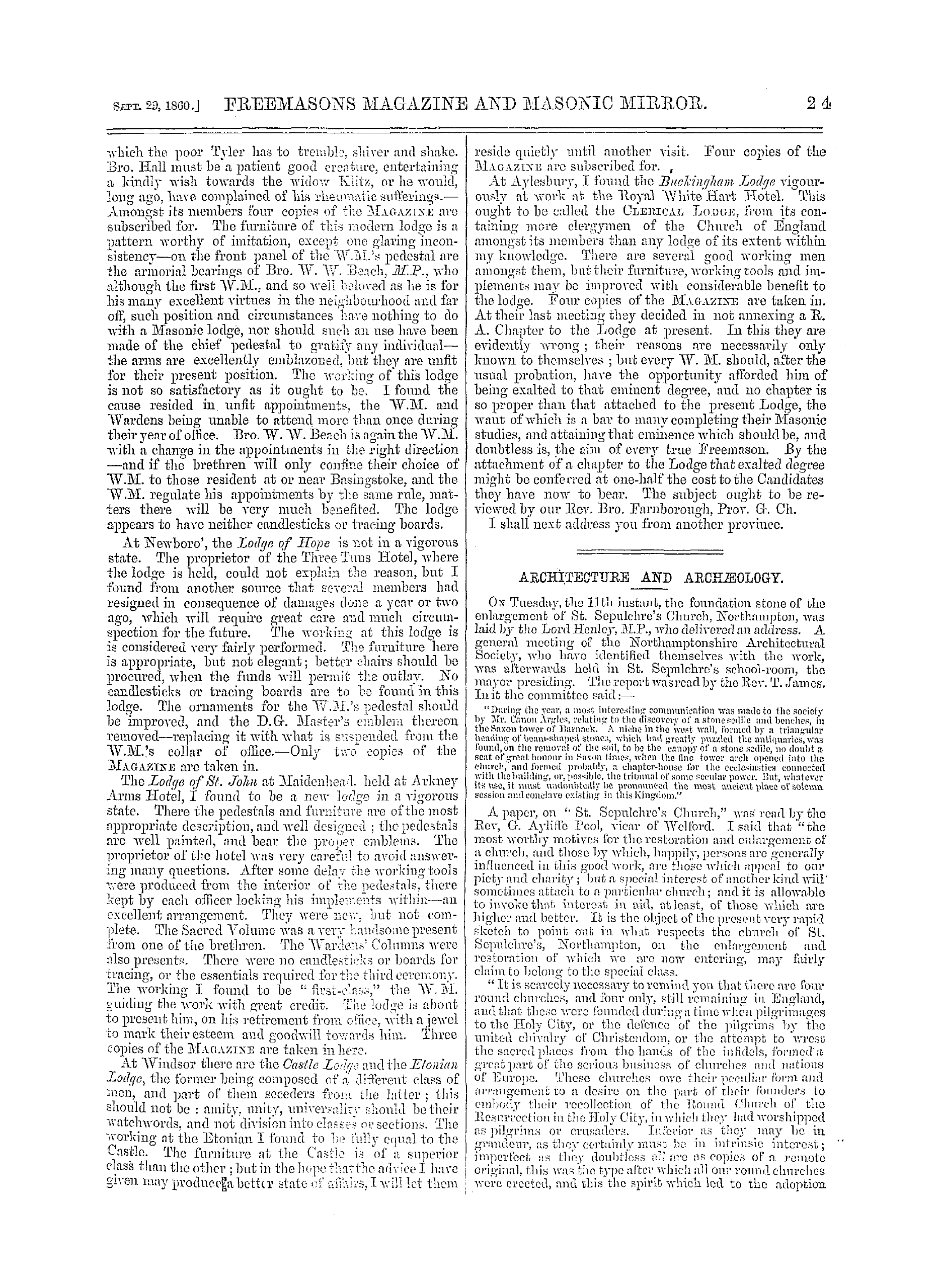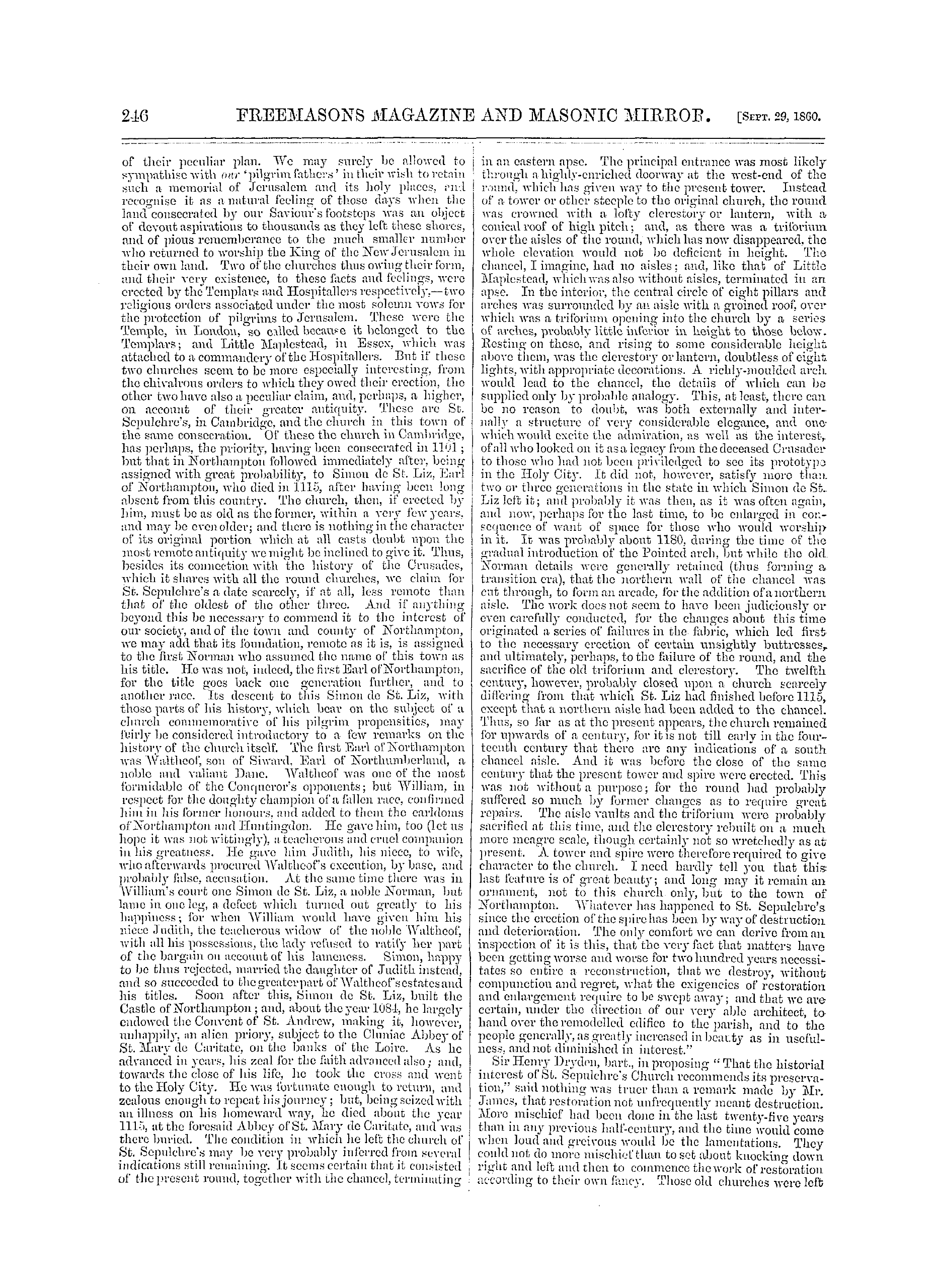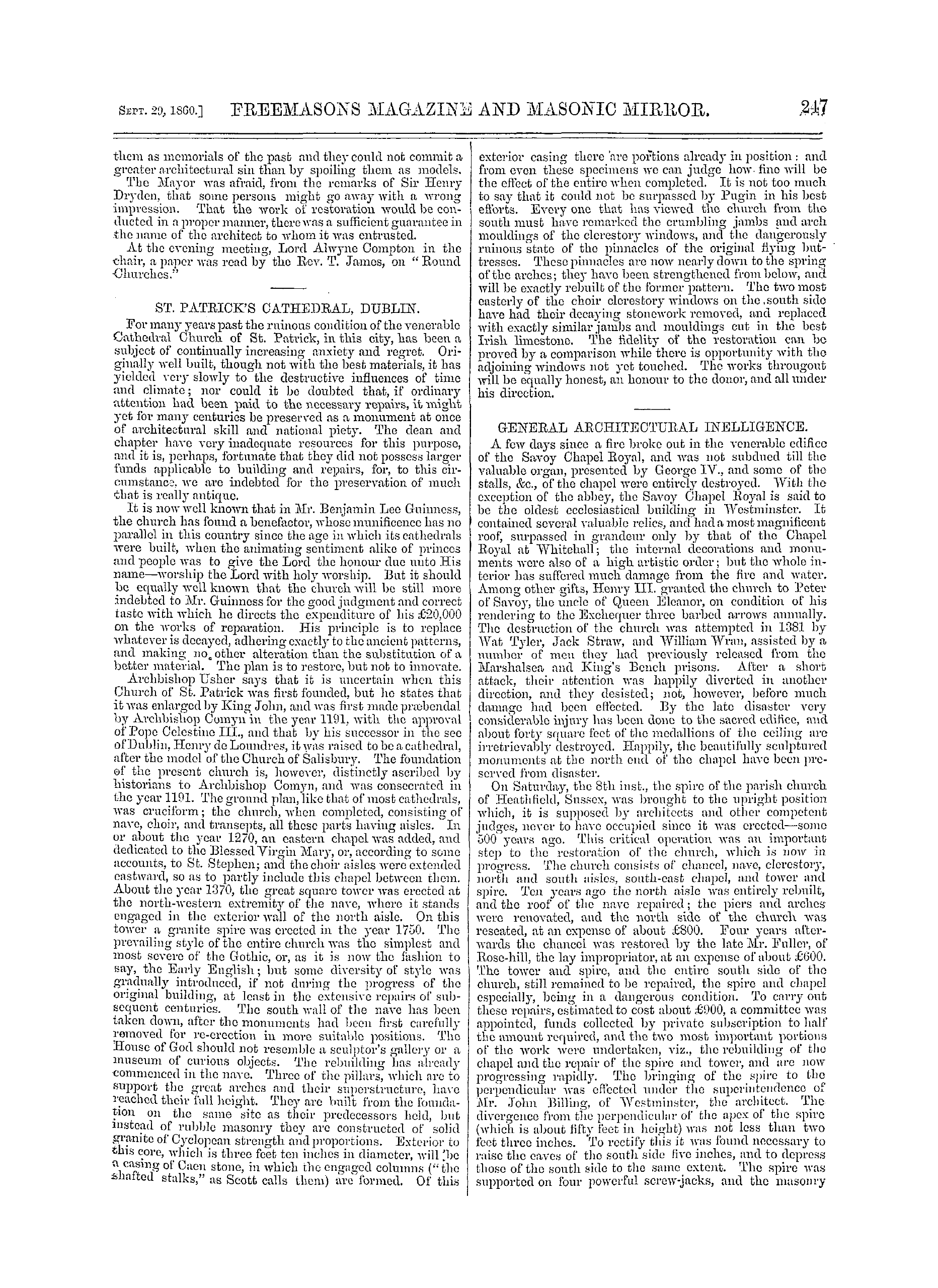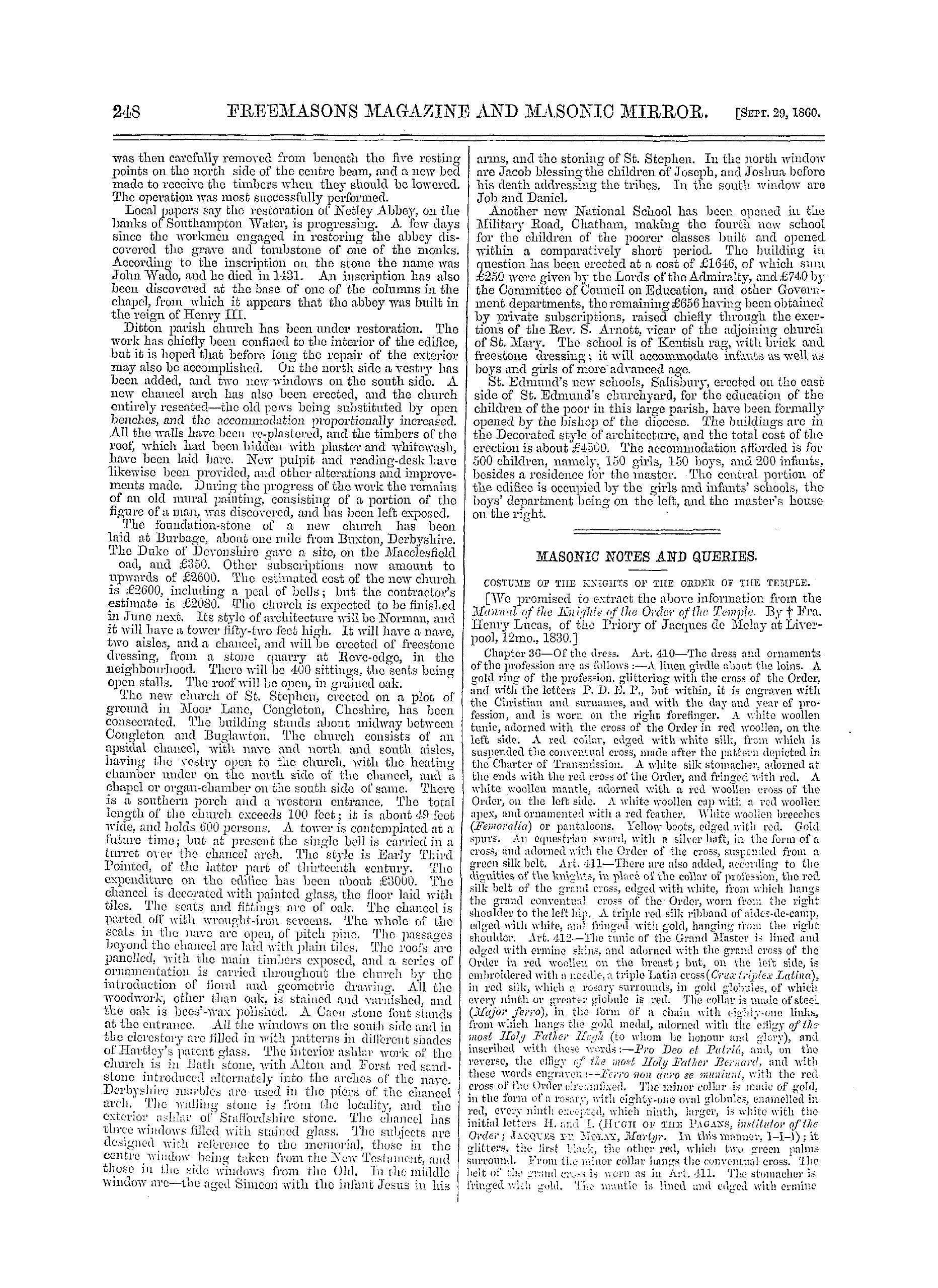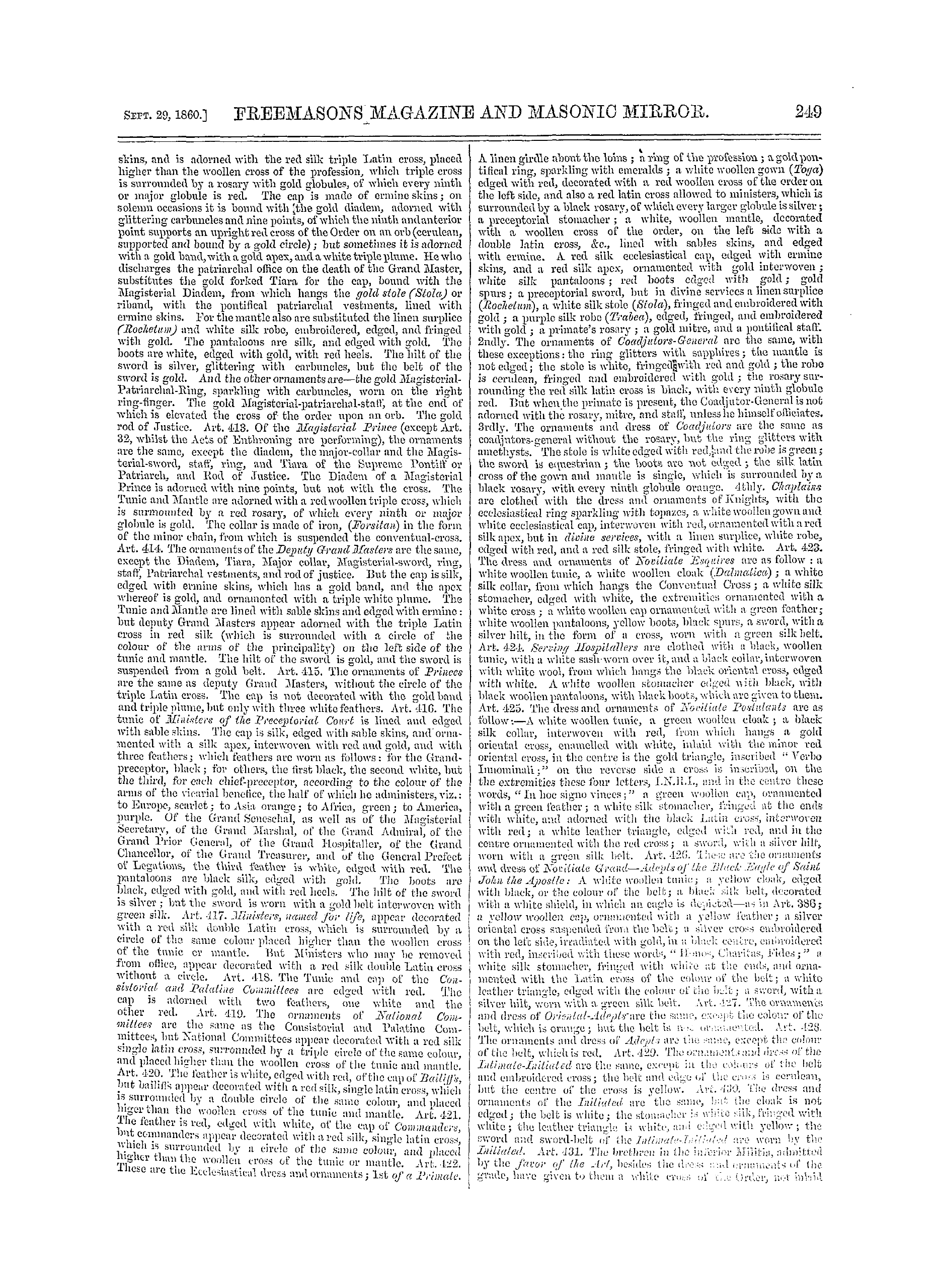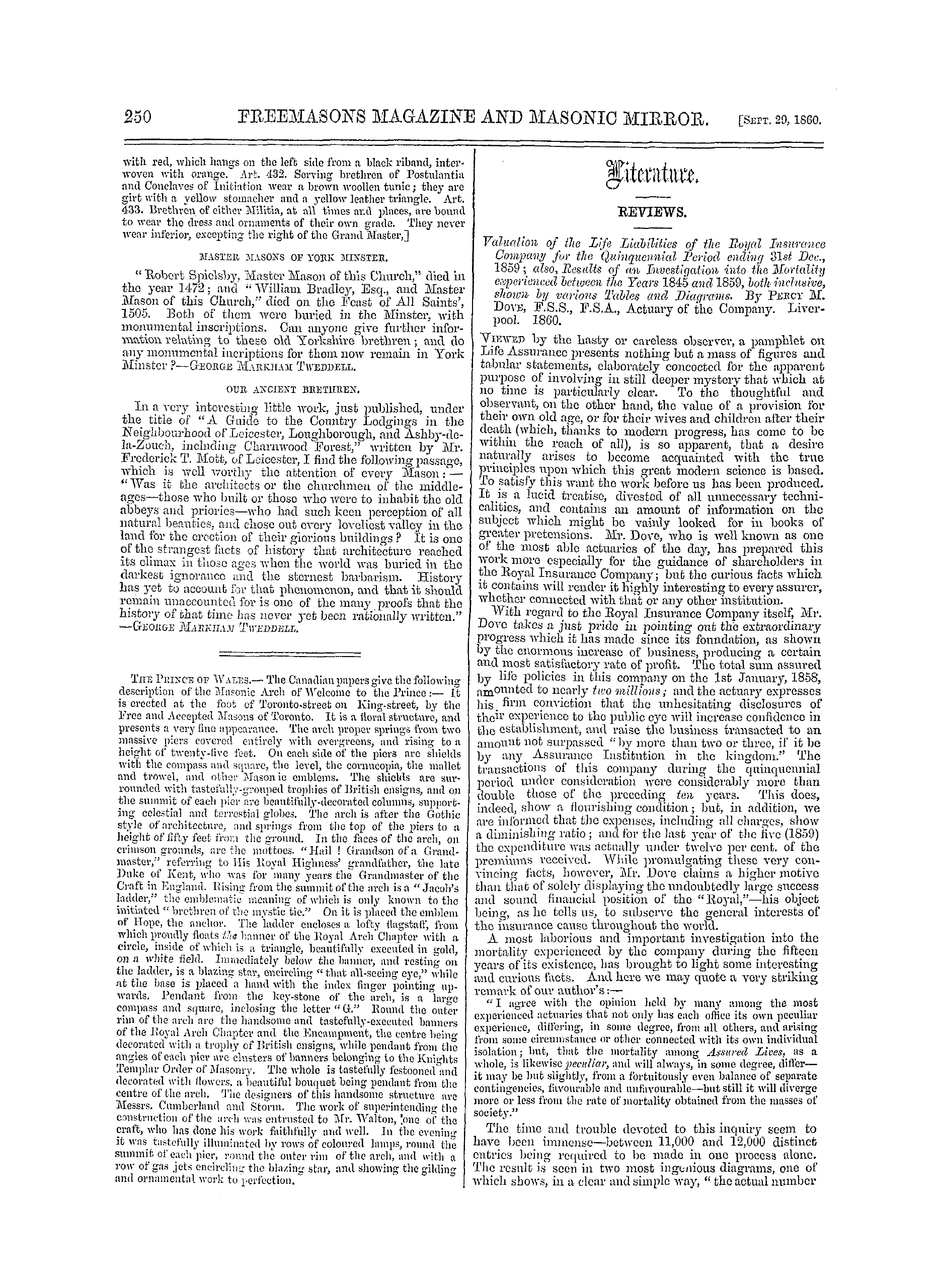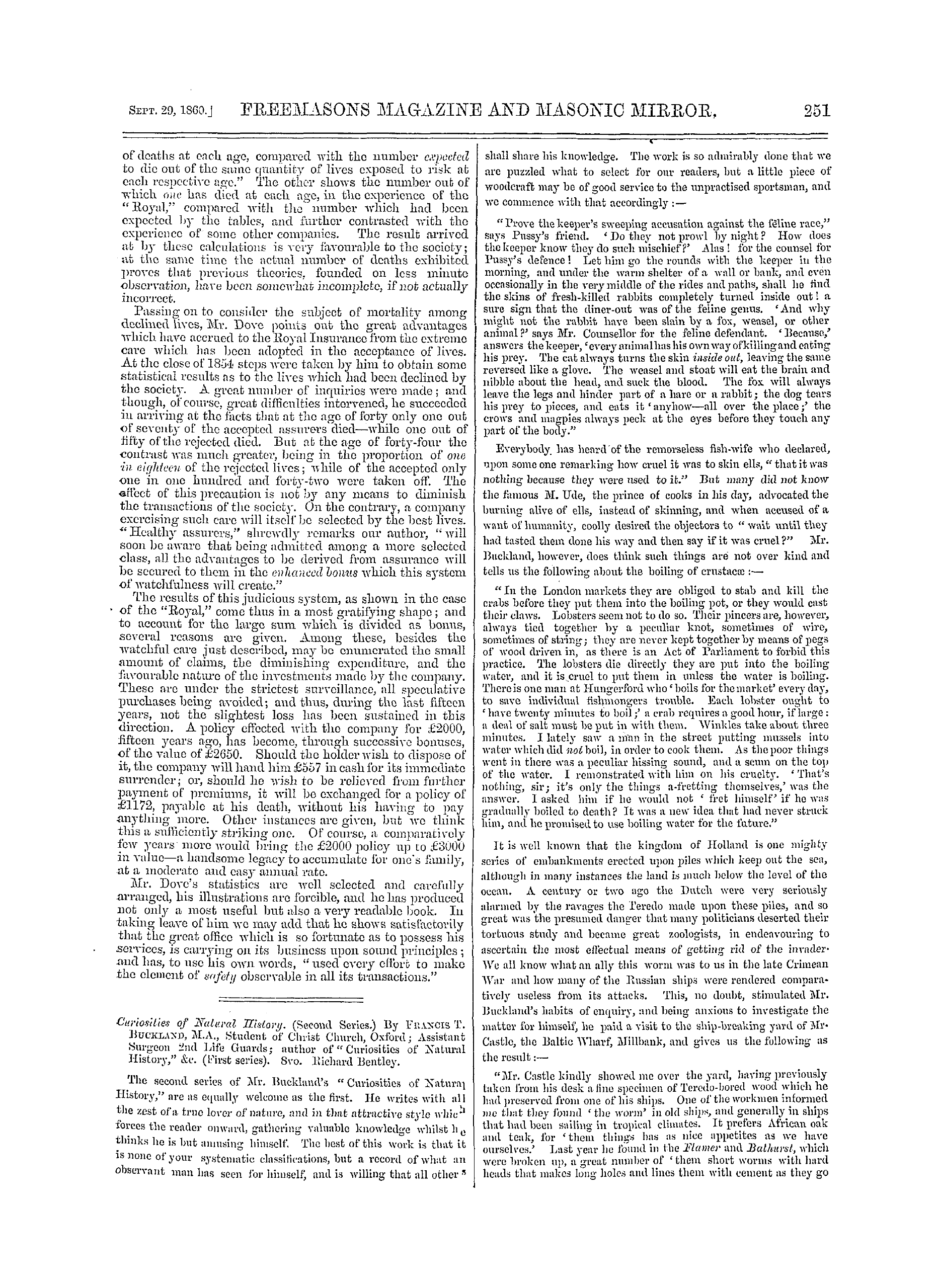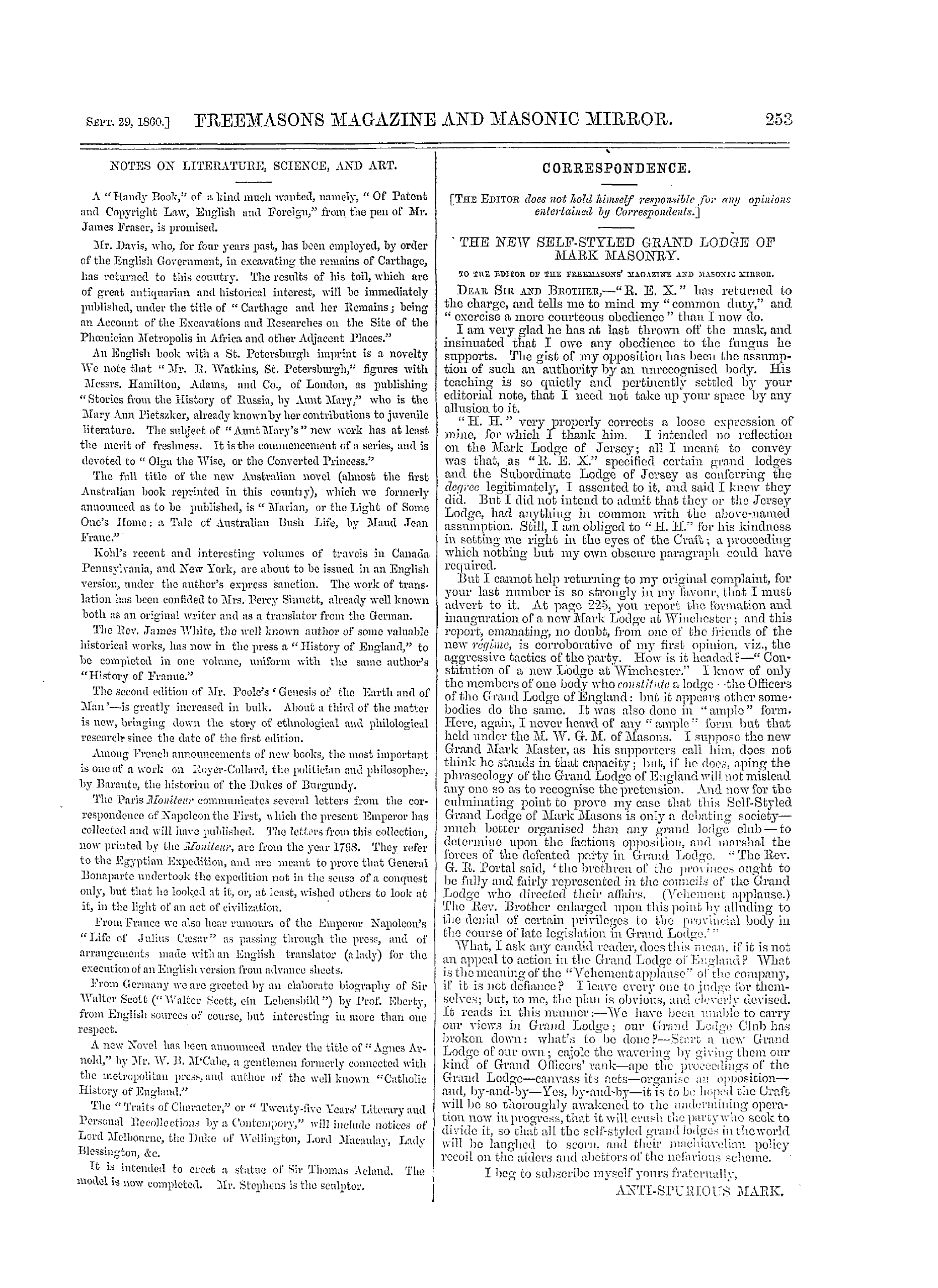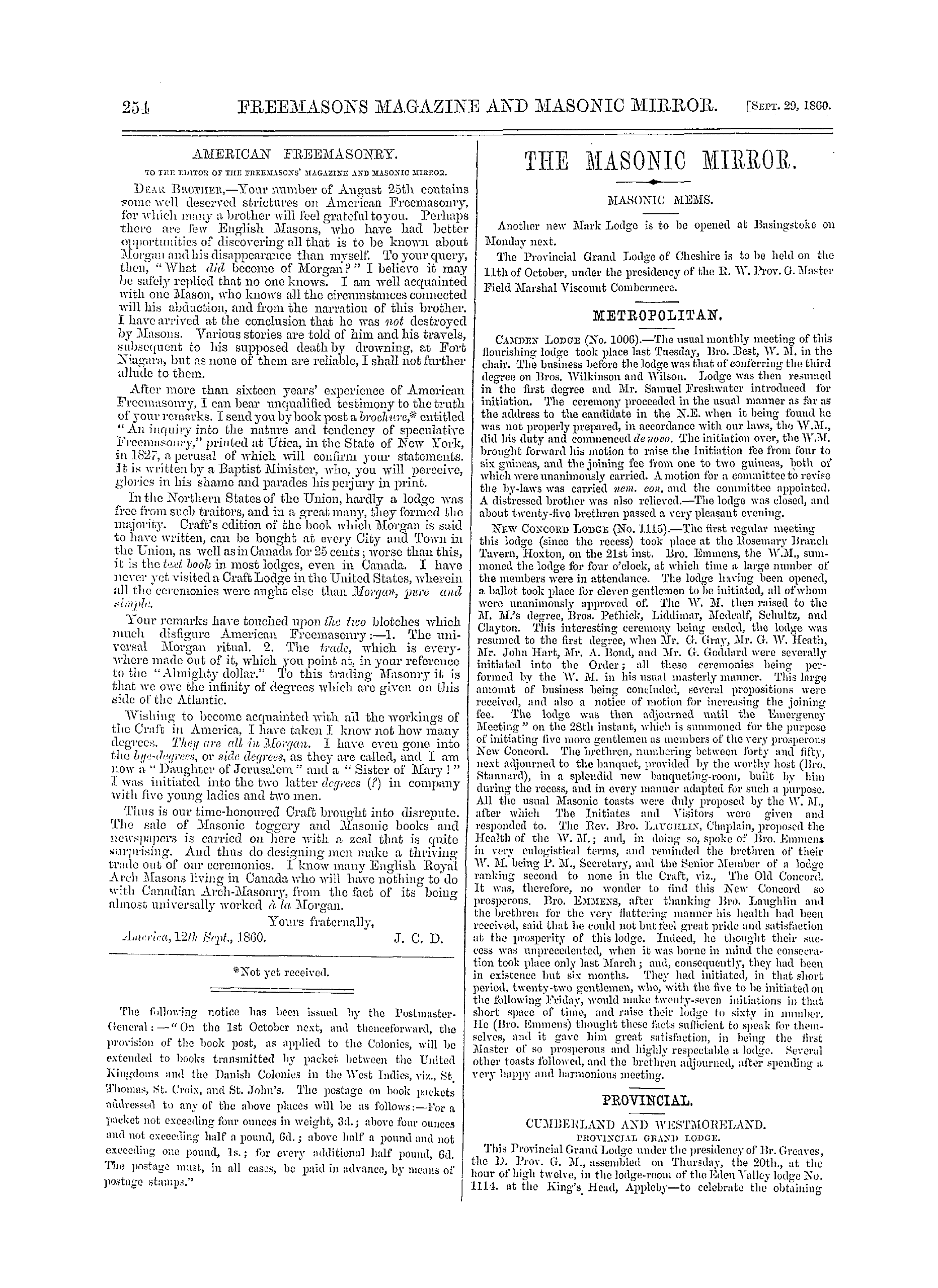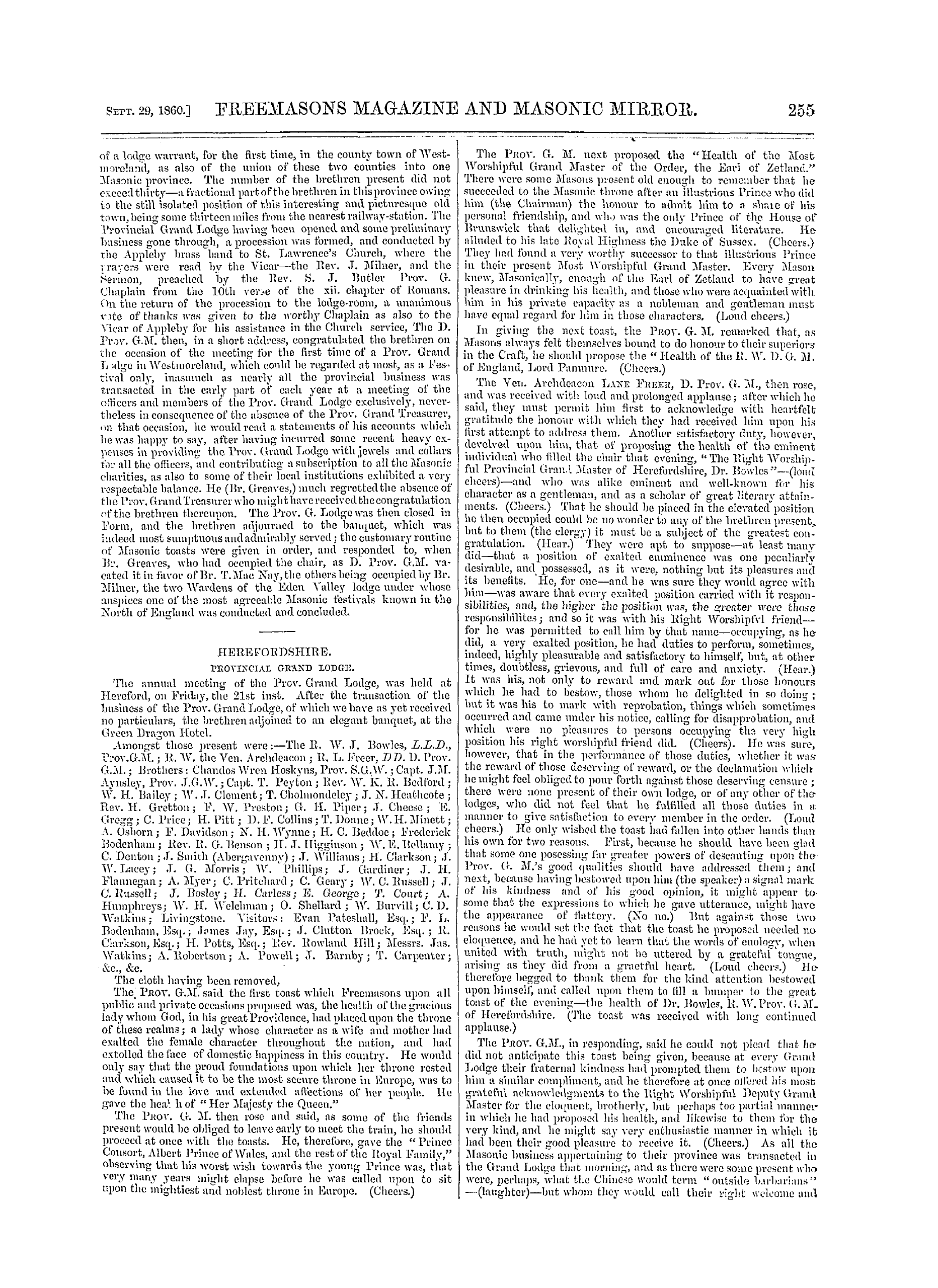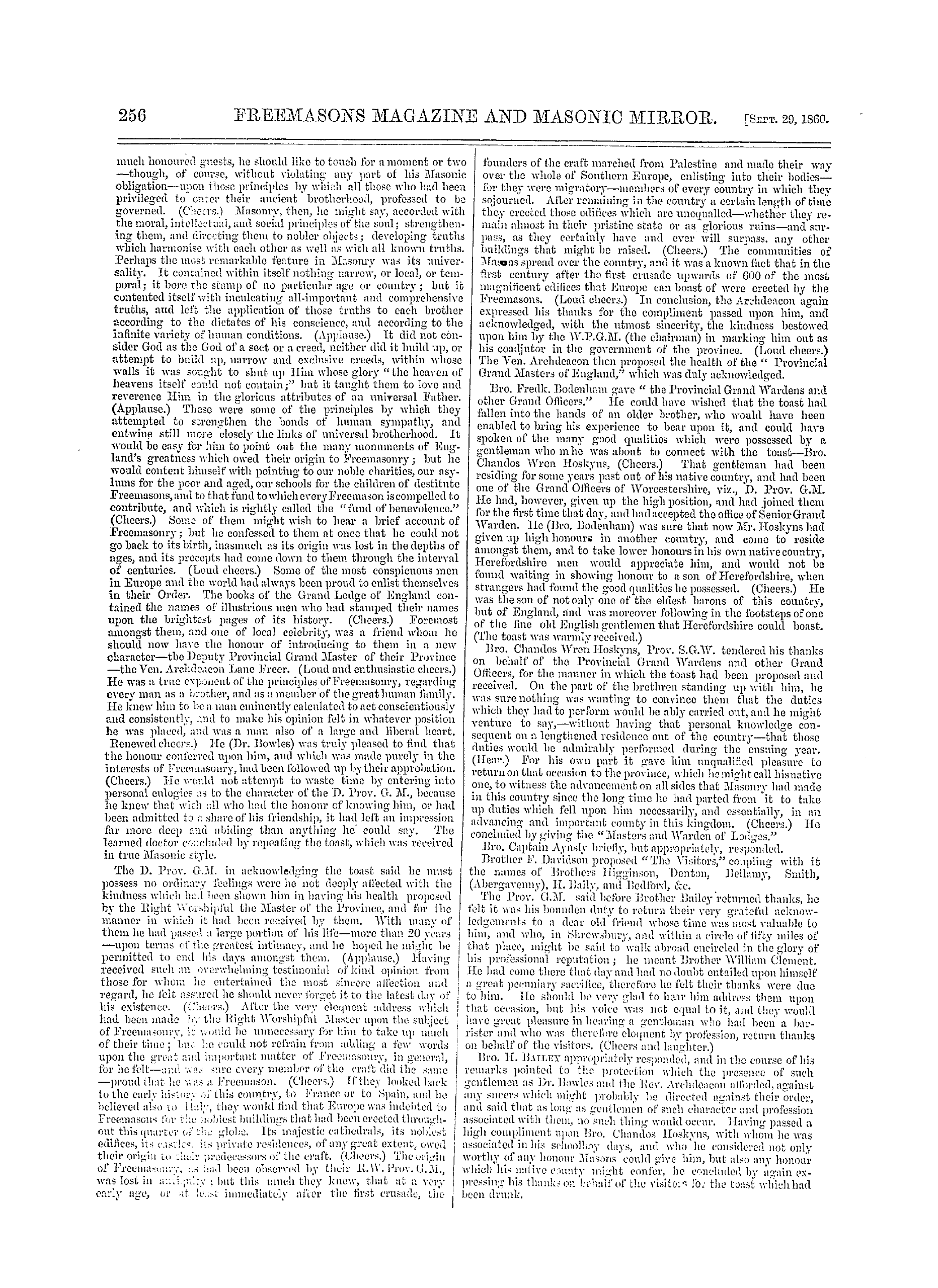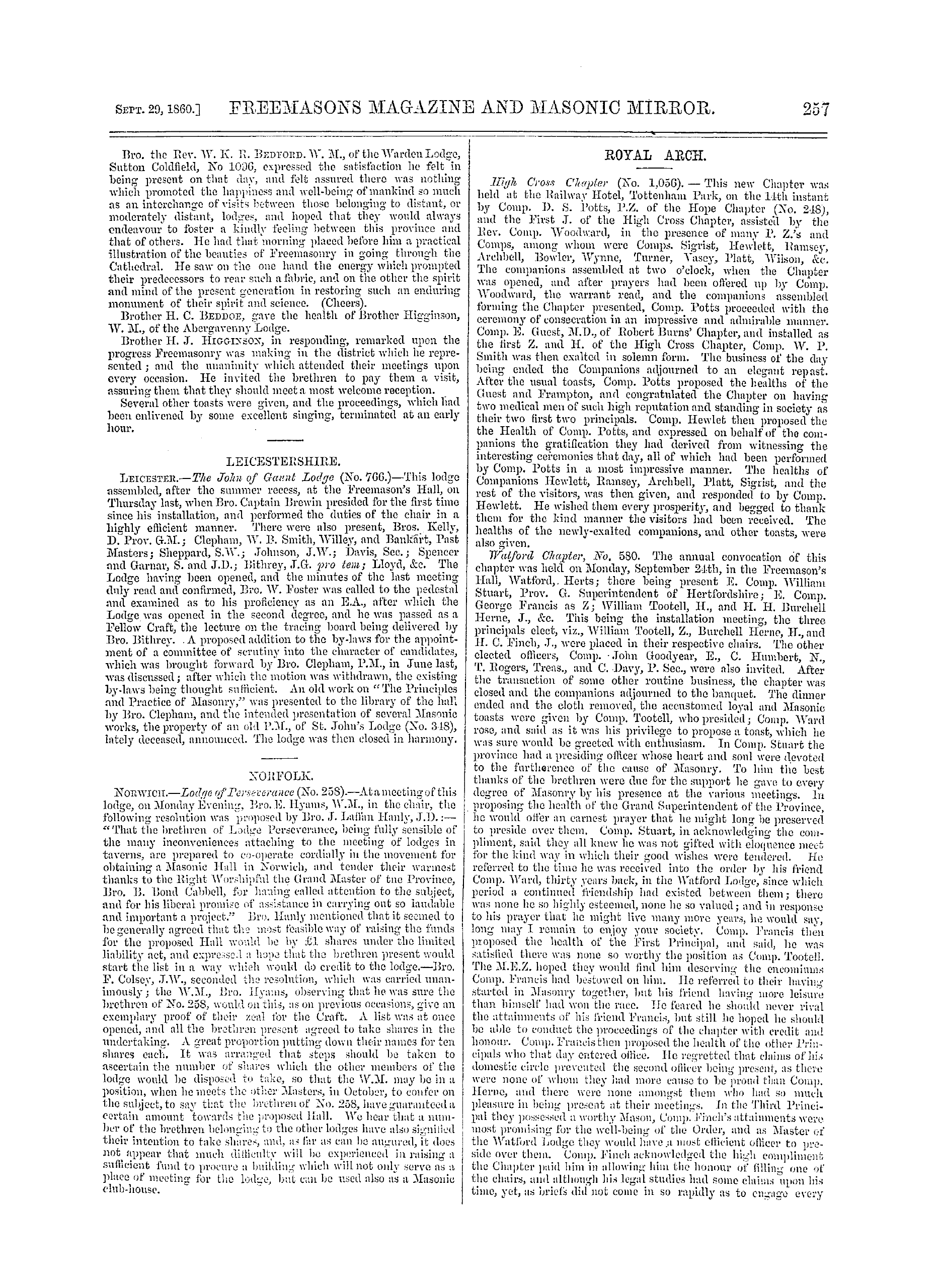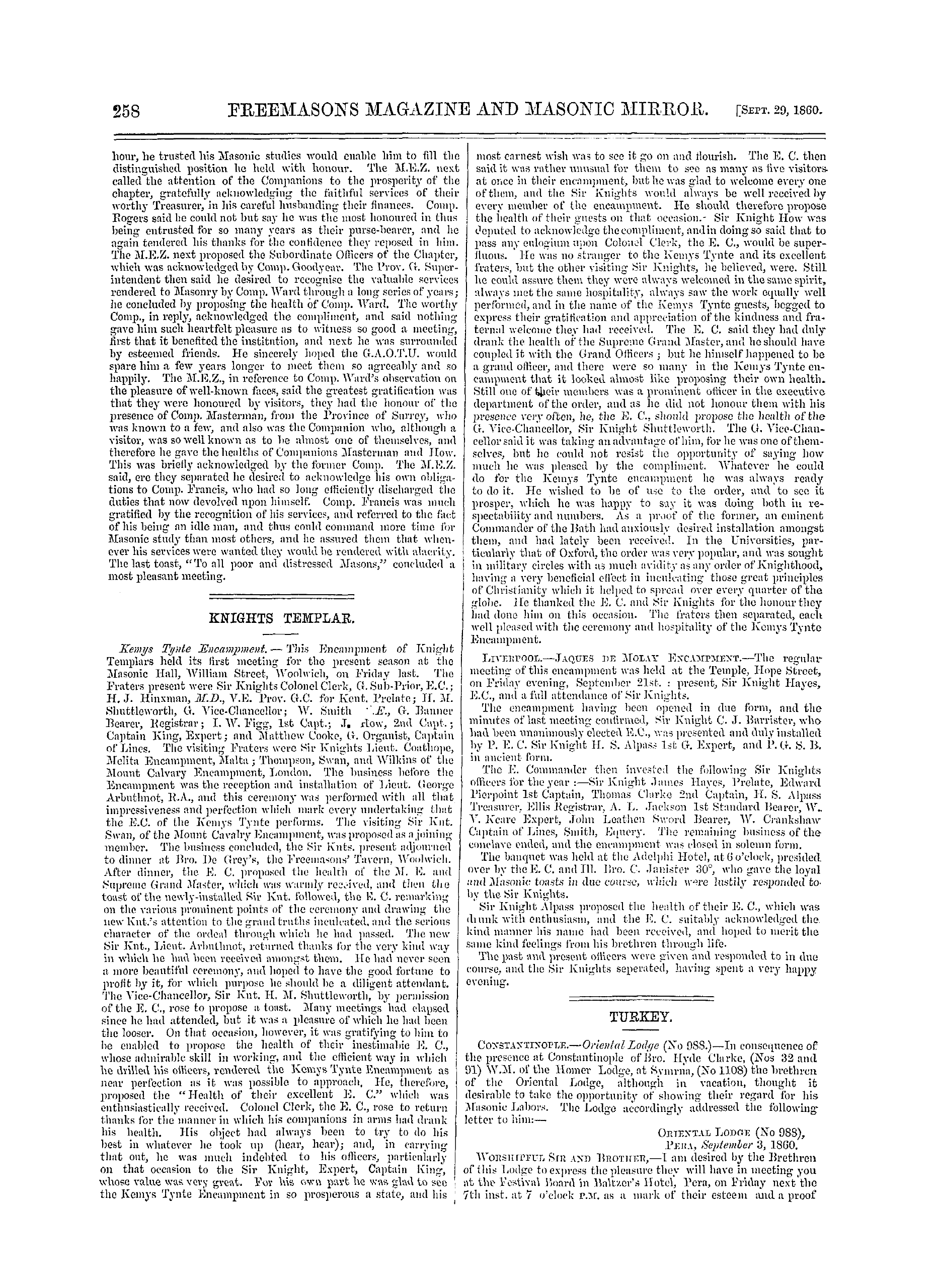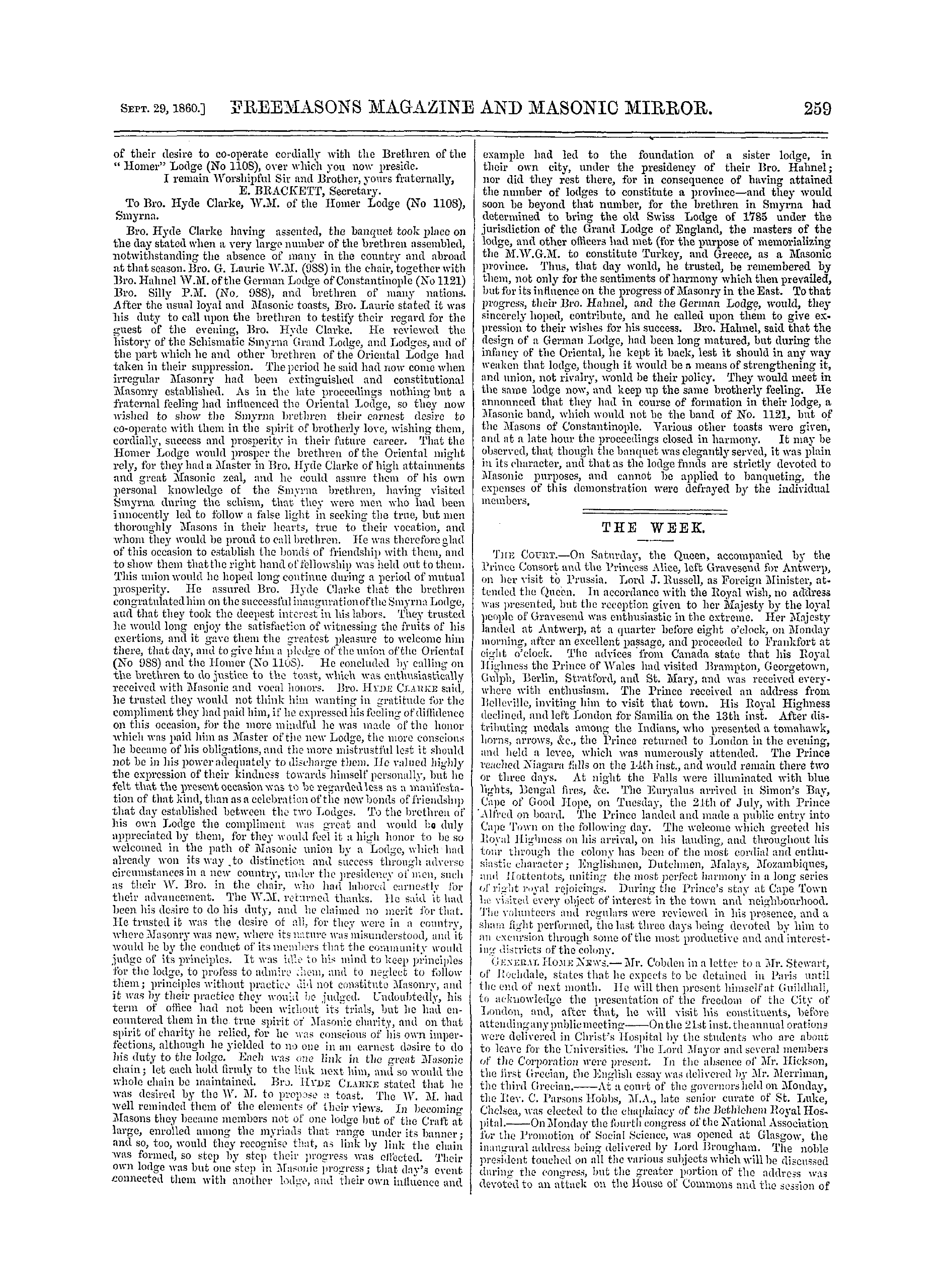-
Articles/Ads
Article ARCHITECTURE AND AECHÆOLOGY. ← Page 3 of 4 →
Note: This text has been automatically extracted via Optical Character Recognition (OCR) software.
Architecture And Aechæology.
them as memorials of thc past aud thei- could not commit a greater architectural sin than by spoiling them as models . The Mayor ivas afraid , from the remarks of Sir Henry Dryden , that some persons might go aivay with a wrong impression . That the work of restoration would be conducted in a proper manner , there was a sufficient guarantee in the name of the architect to whom it was entrusted . At thc evening meeting , Lord Aluyne Compton in the ¦ chair , a paper was read by tho Eev . T . James , on " Bound -Churches . "
ST . PATRICK'S CATHEDRAL , DUBLIN . For many years past the ruinous condition ofthe venerable Cathedral Church of St . Patrick , in this city , has been a subject of continually increasing anxiety and regret . Originally well built , though not with the best materials , it has yielded very slowly to the destructive influences of time and climate ; nor could it bo doubted thatif ordinary
, attention had been paid to the necessary repairs , it might yet for many centuries be preserved as a monument at once of architectural skill and national piety . Tho dean and chapter have very inadequate resources for this purpose , and it is , perhaps , fortunate that they did not possess larger funds applicable to building ancl repairs , for , to this circumstance , we are indebted for the preservation of much
that is really antique . It is now well known that in Mr . Benjamin Lee Guinness , the church has found a benefactor , ivhose munificence has no parallel in this country since the age in which its cathedrals were built , when the animating sentiment alike of princes and people was to give the Lord thc honour duo unto His name—worshithe Lord with holworshi . But it should
p y p be equally ivell known that the church will be still more indebted to Mr . Guinness for thc good judgment and correct taste with which ho directs the expenditure of his £ 20 , 000 on the works of reparation . His principle is to replace whatever is decayed , adhering exactly to tho ancient patterns , and making no , other alteration than the substitution of a better material . The plan is to restorebut not to innovate .
, Archbishop Usher says that it is uncertain when this Church of St . Patrick ivas first founded , but ho states that it was enlarged by King John , and was first made pnubendal by Archbishop Comyn in the year 1191 , with the approval of Pope Cclestino III ., and that by his successor in the see of Dublin , Henry doLoundres , it was raised to be a cathedral ,
after the model of the Church of Salisbury . The foundation of thc present church is , however , distinctly ascribed by historians to Archbishop Comyn , and was consecrated in the year 1191 . The ground plan , like that of most cathedrals , was cruciform ; the church , ivlicn completed , consisting of nave , choir , and transepts , all these parts having aisles . ' In or about thc year 1270 , an eastern chapel was added , and
dedicated to the Blessed Virgin Mary , or , according to some accounts , to St . Stephen ; and thc choir aisles were extended eastward , so as to partly include this chapel between them . About the year 1370 , the great square tower was erected at the north-western extremity of the nave , whore it stands engaged in the exterior wall of the north aisle . On this tower a granite spire was erected in thc year 1750 . Thc
prevailing style of the entire church was the simplest and most severe of the Gothic , or , as it is now thc fashion to say , tho Early English ; but some diversity of style was gradually introduced , if not during the progress " of the original building , at least in the extensive repairs of subsequent centuries . Thc south wall of the nave has been taken down , after tho monuments had been first carefully romoved for erection
re- in more suitable positions . Tho House of God should not resemble a sculptor ' s gallery or a museum of curious objects . The rebuilding ' has alrcady commenccd in the nave . Three of thc pillars , which are to support thc great arches and their superstructure , have reached their full height . They are built from the foundation on the site their predecessors heldbut
same as , instead of rubble masonry they are constructed of solid granite of Cyclopean strength and proportions . Exterior to this core , which is three feet ten inches in diameter , ivill [ be a casing of Caen stone , in ivhieh the engaged columns (" the slmited stalks , " as Scott calls them ) arc formed . Of this
exterior casing there are portions already in position : and from even these specimens wo can judge how- fine ivill bo the effect of the entire when completed . It is not too much to say that it could not bo surpassed by Pngin in his best efforts . Every one that has viewed tho church from the south must have remarked tho crumbling jambs and arch mouldings of tho clerestory windows , and the dangerously
ruinous state of the pinnacles of the original flying buttresses . These pinnacles are now nearly down to the spring ofthe arches ; they have been strengthened from below , and will be exactly rebuilt of fche former pattern . Tho two most easterly of tho choir clerestory windows on the , south side havo had their decaying stonework removed , and replaced with exactlsimilar jambs and mouldings cut in tho best
y Irish limestone . The fidelity of thc restoration can be proved by a comparison ivhile there is opportunity with tho adjoining windows not yet touched . The works througoufc ivill bo equally honest , an honour to tho donor , and all under his direction .
GENERAL ARCHITECTURAL 1 NELLIGENCE . A few days since a fire broke out in the venerable edifice of tho Savoy Chapel Royal , and was not subdued till the valuable organ , presented by George IV ., and some of the stalls , & c , of the chapel were entirely destroyed . With the exception of the abbey , the Savoy Chapel Royal is said to be the oldest ecclesiastical building in Westminster . It
contained several valuable relics , and had a most magnificent roof , surpassed in grandeur only by that of tho Chapel Royal at Whitehall ; the internal decorations and monuments wore also of a high artistic order ; but thc ivhole interior has suffered much damage from the fire and water . Among other gifts , Henry III . granted tho church to Peter of Savoy , the uncle of Queen Eleanor , on condition of his
rendering to the Exchequer three barbed arrows annually . The destruction of the church was attempted in 1381 by-Wat Tyler , Jack Straw , and William Wrau , assisted by a number of men they had previously released from the Marshalsea and King ' s Bench prisons . After a short attack , their attention was happily diverted in another direction , and they desisted ; not , however , before much
damage had been effected . By thc late disaster very considerable injury has been done to the sacred edifice , and about forty square feet of the medallions of the ceiling are irretrievably destroyed . Happily , the beautifully sculptured monuments at thc north end of thc chapel have been preserved from disaster . On Saturdaythc Sth insfc . tho ire of thc parish church
, , sp of Heathfield , Sussex , ivas brought to the upright position which , ifc is supposed by architects and other competent ; judges , never to have occupied since it was erected—some 500 years ago . This critical operation was an important
step to thc restoration of the church , which is now in progress . The church consists of chancel , nave , clerestoiy , north and south aisles , south-cast chapel , ancl tower and spire . Ton years ago the north aisle was entirely rebuilt , ancl thc roof of the nave repaired ; thc piers and arches were renovated , and thc north side of thc church was reseated , at an expense of about £ ' 800 . Four years
afterwards thc chancel was restored by the late Mr . Fuller , of Rose-hill , thc lay impropriator , at an expense of about £ 600 . Thc tower and spire , and tho entire south side of tlic church , still remained to be repaired , the spire and chapel especially , being in a dangerous condition . To carry out these repairs , estimated to cost about £ 900 , a committee was appointedfunds collected by private subscription to half
, tho amount required , and the two most important portions of the work were undertaken , viz ., tho rebuilding of tho chapel and thc repair of the spire and towei ' , and are noiv progressing rapidly . Thc bringing of thc spire to the perpendicular was effected under the superintendence of Mr . John Billing , of Westminster , tbe architect . The divergence from the perpendicular of tho apex of the spire
( ivhieh is about fifty feet in height ) was not loss than two feet three inches . To rectify this it ivas found necessary to raise thc eaves of tho south side five inches , and to depress those ofthe south side to tho same extent . The spire was supported on four powerful screw-jacks , and thc masonry
Note: This text has been automatically extracted via Optical Character Recognition (OCR) software.
Architecture And Aechæology.
them as memorials of thc past aud thei- could not commit a greater architectural sin than by spoiling them as models . The Mayor ivas afraid , from the remarks of Sir Henry Dryden , that some persons might go aivay with a wrong impression . That the work of restoration would be conducted in a proper manner , there was a sufficient guarantee in the name of the architect to whom it was entrusted . At thc evening meeting , Lord Aluyne Compton in the ¦ chair , a paper was read by tho Eev . T . James , on " Bound -Churches . "
ST . PATRICK'S CATHEDRAL , DUBLIN . For many years past the ruinous condition ofthe venerable Cathedral Church of St . Patrick , in this city , has been a subject of continually increasing anxiety and regret . Originally well built , though not with the best materials , it has yielded very slowly to the destructive influences of time and climate ; nor could it bo doubted thatif ordinary
, attention had been paid to the necessary repairs , it might yet for many centuries be preserved as a monument at once of architectural skill and national piety . Tho dean and chapter have very inadequate resources for this purpose , and it is , perhaps , fortunate that they did not possess larger funds applicable to building ancl repairs , for , to this circumstance , we are indebted for the preservation of much
that is really antique . It is now well known that in Mr . Benjamin Lee Guinness , the church has found a benefactor , ivhose munificence has no parallel in this country since the age in which its cathedrals were built , when the animating sentiment alike of princes and people was to give the Lord thc honour duo unto His name—worshithe Lord with holworshi . But it should
p y p be equally ivell known that the church will be still more indebted to Mr . Guinness for thc good judgment and correct taste with which ho directs the expenditure of his £ 20 , 000 on the works of reparation . His principle is to replace whatever is decayed , adhering exactly to tho ancient patterns , and making no , other alteration than the substitution of a better material . The plan is to restorebut not to innovate .
, Archbishop Usher says that it is uncertain when this Church of St . Patrick ivas first founded , but ho states that it was enlarged by King John , and was first made pnubendal by Archbishop Comyn in the year 1191 , with the approval of Pope Cclestino III ., and that by his successor in the see of Dublin , Henry doLoundres , it was raised to be a cathedral ,
after the model of the Church of Salisbury . The foundation of thc present church is , however , distinctly ascribed by historians to Archbishop Comyn , and was consecrated in the year 1191 . The ground plan , like that of most cathedrals , was cruciform ; the church , ivlicn completed , consisting of nave , choir , and transepts , all these parts having aisles . ' In or about thc year 1270 , an eastern chapel was added , and
dedicated to the Blessed Virgin Mary , or , according to some accounts , to St . Stephen ; and thc choir aisles were extended eastward , so as to partly include this chapel between them . About the year 1370 , the great square tower was erected at the north-western extremity of the nave , whore it stands engaged in the exterior wall of the north aisle . On this tower a granite spire was erected in thc year 1750 . Thc
prevailing style of the entire church was the simplest and most severe of the Gothic , or , as it is now thc fashion to say , tho Early English ; but some diversity of style was gradually introduced , if not during the progress " of the original building , at least in the extensive repairs of subsequent centuries . Thc south wall of the nave has been taken down , after tho monuments had been first carefully romoved for erection
re- in more suitable positions . Tho House of God should not resemble a sculptor ' s gallery or a museum of curious objects . The rebuilding ' has alrcady commenccd in the nave . Three of thc pillars , which are to support thc great arches and their superstructure , have reached their full height . They are built from the foundation on the site their predecessors heldbut
same as , instead of rubble masonry they are constructed of solid granite of Cyclopean strength and proportions . Exterior to this core , which is three feet ten inches in diameter , ivill [ be a casing of Caen stone , in ivhieh the engaged columns (" the slmited stalks , " as Scott calls them ) arc formed . Of this
exterior casing there are portions already in position : and from even these specimens wo can judge how- fine ivill bo the effect of the entire when completed . It is not too much to say that it could not bo surpassed by Pngin in his best efforts . Every one that has viewed tho church from the south must have remarked tho crumbling jambs and arch mouldings of tho clerestory windows , and the dangerously
ruinous state of the pinnacles of the original flying buttresses . These pinnacles are now nearly down to the spring ofthe arches ; they have been strengthened from below , and will be exactly rebuilt of fche former pattern . Tho two most easterly of tho choir clerestory windows on the , south side havo had their decaying stonework removed , and replaced with exactlsimilar jambs and mouldings cut in tho best
y Irish limestone . The fidelity of thc restoration can be proved by a comparison ivhile there is opportunity with tho adjoining windows not yet touched . The works througoufc ivill bo equally honest , an honour to tho donor , and all under his direction .
GENERAL ARCHITECTURAL 1 NELLIGENCE . A few days since a fire broke out in the venerable edifice of tho Savoy Chapel Royal , and was not subdued till the valuable organ , presented by George IV ., and some of the stalls , & c , of the chapel were entirely destroyed . With the exception of the abbey , the Savoy Chapel Royal is said to be the oldest ecclesiastical building in Westminster . It
contained several valuable relics , and had a most magnificent roof , surpassed in grandeur only by that of tho Chapel Royal at Whitehall ; the internal decorations and monuments wore also of a high artistic order ; but thc ivhole interior has suffered much damage from the fire and water . Among other gifts , Henry III . granted tho church to Peter of Savoy , the uncle of Queen Eleanor , on condition of his
rendering to the Exchequer three barbed arrows annually . The destruction of the church was attempted in 1381 by-Wat Tyler , Jack Straw , and William Wrau , assisted by a number of men they had previously released from the Marshalsea and King ' s Bench prisons . After a short attack , their attention was happily diverted in another direction , and they desisted ; not , however , before much
damage had been effected . By thc late disaster very considerable injury has been done to the sacred edifice , and about forty square feet of the medallions of the ceiling are irretrievably destroyed . Happily , the beautifully sculptured monuments at thc north end of thc chapel have been preserved from disaster . On Saturdaythc Sth insfc . tho ire of thc parish church
, , sp of Heathfield , Sussex , ivas brought to the upright position which , ifc is supposed by architects and other competent ; judges , never to have occupied since it was erected—some 500 years ago . This critical operation was an important
step to thc restoration of the church , which is now in progress . The church consists of chancel , nave , clerestoiy , north and south aisles , south-cast chapel , ancl tower and spire . Ton years ago the north aisle was entirely rebuilt , ancl thc roof of the nave repaired ; thc piers and arches were renovated , and thc north side of thc church was reseated , at an expense of about £ ' 800 . Four years
afterwards thc chancel was restored by the late Mr . Fuller , of Rose-hill , thc lay impropriator , at an expense of about £ 600 . Thc tower and spire , and tho entire south side of tlic church , still remained to be repaired , the spire and chapel especially , being in a dangerous condition . To carry out these repairs , estimated to cost about £ 900 , a committee was appointedfunds collected by private subscription to half
, tho amount required , and the two most important portions of the work were undertaken , viz ., tho rebuilding of tho chapel and thc repair of the spire and towei ' , and are noiv progressing rapidly . Thc bringing of thc spire to the perpendicular was effected under the superintendence of Mr . John Billing , of Westminster , tbe architect . The divergence from the perpendicular of tho apex of the spire
( ivhieh is about fifty feet in height ) was not loss than two feet three inches . To rectify this it ivas found necessary to raise thc eaves of tho south side five inches , and to depress those ofthe south side to tho same extent . The spire was supported on four powerful screw-jacks , and thc masonry
